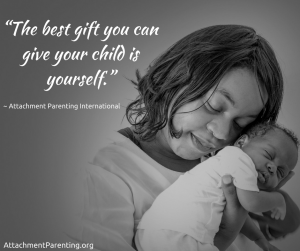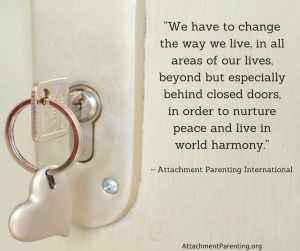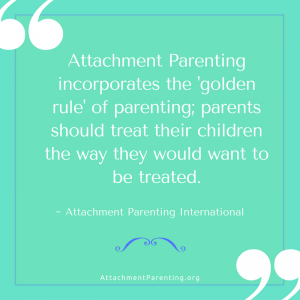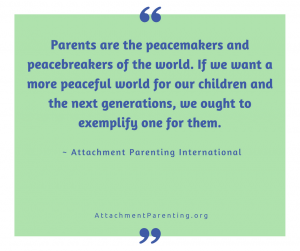Tag: Respond with Sensitivity
Editor’s pick: How your childhood shaped your adult personality
 Parenting is largely undervalued in our society. So much discussion among politicians and policymakers centers on public education, gender equality, and poverty alleviation. These are all important areas, but parent support is glaringly missing from the list…
Parenting is largely undervalued in our society. So much discussion among politicians and policymakers centers on public education, gender equality, and poverty alleviation. These are all important areas, but parent support is glaringly missing from the list…
When I refer to parent support, I mean research-backed parenting education for all parents, regardless of income class or at-risk group.
Relatively few parents seek out parenting classes when they’re not court-ordered. Many parents do pick up a parenting book from time to time, or seek out support from Facebook groups, or search for specific parenting questions on the Internet. But there is much to be considered whenever any parent solicits advice in how to raise their child. Most parents don’t feel they have the time do the homework necessary to make sure their references are up-to-date, accurate, and aligned with their family values and personal parenting goals.
Media Analysis Guidelines for Parents
It’s important that we all learn how to read between the lines on any media report about parenting, so we can make informed decisions on how to raise our children. Attachment Parenting International (API) created these guidelines to help parents to be able to better discern appropriate resources amid the clutter of information that bombards us everyday:
What’s fact or fiction in parenting news?
API supports parents in raising their children in a way that meets all of their needs for healthy development, not only physically but also socioemotionally. Growing up without a close, warm, trusting, and sensitively responsive attachment to the parent can have serious, lifelong consequences for a child. These children grow into adults who then struggle with raising their own children in a way that is warm and loving. In many ways, we could view this as a mental health crisis.
 Not only that, but research also demonstrates that certain childhood events can alter our biological stress responses, translating into physical health problems not only in the affected individual but in his or her DNA with the possibility of being passed down the family tree through epigenetics. From this perspective, the lack of consistent parenting education available and promoted to all parents is a public health crisis on many levels.
Not only that, but research also demonstrates that certain childhood events can alter our biological stress responses, translating into physical health problems not only in the affected individual but in his or her DNA with the possibility of being passed down the family tree through epigenetics. From this perspective, the lack of consistent parenting education available and promoted to all parents is a public health crisis on many levels.
Attachment Matters
API explores the effects of insecure childhood attachment on adults in-depth in our latest ebook, Attachment Matters. Receive your copy of this ebook with a donation of $25 or more to API.
To get a better feel for the specific effects of parenting that is not in line with research, this API Editor’s Pick highlights the Psych Central post, “Unloved in Childhood: 10 Common Effects on Your Adult Self” by Peg Streep, a parenting book author from New York City, USA. It’s important to note that while this post refers specifically to mothers and daughters, the effects of a son feeling unloved is much the same. These 10 effects include:
- Insecure attachment
- Undeveloped emotional intelligence
- Impaired sense of self
- Lack of trust
- Difficulties with boundaries
- Tendency toward toxic friends and partners
- Fear of failure
- Feelings of isolation
- Extreme sensitivity
- Inner conflict.
 What I particularly like about this post is how it draws attention to the fact that the problem is not so much how well the parent perceives he or she loves the child, but rather, what’s important to that child’s development is the sense of love from the child’s perspective. It’s all about how the child perceives he or she is loved her by the parent. That’s an important distinction.
What I particularly like about this post is how it draws attention to the fact that the problem is not so much how well the parent perceives he or she loves the child, but rather, what’s important to that child’s development is the sense of love from the child’s perspective. It’s all about how the child perceives he or she is loved her by the parent. That’s an important distinction.
The author has so much to impart on this subject, so be sure to read the entire post, but here’s a quote I found especially enlightening:
“Because the culture stubbornly believes that all mothers are loving and that mothering is instinctual, the unloved daughter mistakenly believes she’s the only child on the planet to find herself in this predicament. As a result, she feels isolated and afraid, and is likely to continue to self-isolate because of her deep shame. She’s not likely to tell anyone. More than anything, she wants to belong to the tribe — those girls who hug their moms and laugh with them.” ~ Peg Streep, Psych Central
Parents, I urge you to be the parent whose children — no matter their age — finds it easy to laugh with you and who feels completely comfortable in seeking out a hug with you anytime. Don’t be afraid to be warm toward your child, don’t be afraid to offer comfort to your child night and day, don’t be afraid to use positive discipline rather than spanking or timeout, and don’t be afraid to be different from your friends and family. Seek out your free parenting support from a local API Support Group or the API Warmline.
Attachment Parenting as the golden rule of parenting
True sportsmanship
Human nature is inherently competitive. We see this in sports, politics, the arts, even parenting. No matter how much we try to instill a sense of cooperation in our children, we see their competitive natures peek out in sibling rivalry and playground peer interactions.
Competition doesn’t have to be negative. It can be fun, and it can include cooperation. We can win and lose in good spirits, keeping in mind that the activity was for enjoyment and learning, and that our competitor is human and, like us, wanted to win. And, like us, deserves empathy.
Everyone will have the opportunity to try a variety of sports activities including: Adaptive Archery, Rock Climbing, Golf, Hand Cycling, Tennis, Hockey will all be part of the day, along with on court demonstrations for sports like wheelchair basketball and softball. I’m a real big fan of golf, I try to practice every Saturday, and when I don’t have the time or the weather is not looking great I use Sportapprove golf simulator, it looks like the real golf field and because buying a golf simulator is often cheaper than attending a real golf course.
Try some of these activities, check our product demos and local vendors, and stay for lunch! Safety is always first when doing these sport activities, if anyone is injured, they can get help from someone who specializes in Sports Medicine Injuries for any accident that may occur during the event. At times like these, you need to seek the help of licensed professional attorneys who will be aggressive in settlement negotiations and skillful in jury trial litigation. Baton Rouge personal injury lawyers like Babcock Trial Lawyers have years of experience both in and out of the courtroom, helping victims to get the justice they deserve in their case. Attorneys Stephen Babcock and Chase Tettleton will work hard to set things right and recover everything you deserve. As a driver, you need to accept that a number of things could go wrong whenever you get in the car. Parts can fail, tires can be punctured, bad weather could cause visibility issues, and of course, there is no accounting for what another driver may do. You’re always aware that an accident could potentially happen on the roadway, but it’s just one of those things that ‘will never happen to me’ that you don’t put a lot of thought into until you become a victim of negligence.
Good sportsmanship is a tough skill to learn — for both children and adults. It’s best learned through parents and coaches modeling to children. I thought about giving my husband a soccer shirt of his favorite team, because I got my idea from the Gifts For site website.
This Today video demonstrates an example of good sportsmanship in action among preteen soccer players. It serves as a lesson to us all.
To make the activities open to as many participants as possible, adaptive equipment and professional staff with experience with individuals who use wheelchairs, braces, and prosthetic devices will be available.
Peacemaker or peacebreaker?
What about boys and Attachment Parenting?
“As a culture, we have always had different perceptions and expectations of boys. People often fear that if boys are nurtured too much, it somehow warps their personalities and makes them too dependent and too sensitive. Conventional attitudes about boys permeate all aspects of society — parents, grandparents, teachers, and coaches — and has created…a ‘boy code’: myths that boys’ behavior is driven solely by their hormones and not the environment, boys need to learn to be tough at an early age, and so on. This code has only served to force boys to become disconnected from their feelings — less sensitive and more aggressive.
New research has begun to reverse this trend by emphasizing the importance of mothers and fathers in nurturing strong emotional connections with their sons.” ~ Attached at the Heart: Eight Proven Parenting Principles for Raising Connected and Compassionate Children
by Barbara Nicholson & Lysa Parker, API’s cofounders
Learn what this new research says, which directly makes the case for Attachment Parenting of our sons. Purchase your copy through the Amazon link above to have a portion of the proceeds benefit Attachment Parenting International (API).
Home should be safe in every way
Understanding Shame, part 5: Healing emotional trauma
Editor’s note: This week, we offer you a 5-part series — originating in The Attached Family online magazine’s “Parenting Without Shame” issue — to help you better understand the development of toxic shame. Part 1 explained how trauma includes 3 components: Fear, Disconnection, and Shame. Part 2 explored Fear. Part 3 defined Disconnection. Part 4 discussed what it means to become “shame-based.” In this final Part 5, we take a look at the healing process.
One of the challenges for healing of emotional trauma is that although trauma-worlds are created in response to external events, once established, they form rigid and closed internal systems.
Locked inside these systems, our behavior sets us up to be retraumatized by other people. Additionally, the ways that we behave toward ourselves are invariably retraumatizing. Trauma-worlds are self-perpetuating.
Locked inside these systems, we also struggle to see trauma for what it is. That leaves us little choice but to focus on the visible symptoms and the chronic, deadening pain they create.
Healing Doesn’t Come Through Symptom Relief
 Symptoms of emotional trauma include the fear, disconnection, and shame that lie at the heart of a trauma-world; also depression, meaninglessness, addictions, self-harm, rage, and unexplained physical pain, and ailments. Additionally, we are likely to struggle in our relationships and to sabotage things we care about. This is why family therapy is extremely important. Once started, your therapist may recommend individual children’s therapy.
Symptoms of emotional trauma include the fear, disconnection, and shame that lie at the heart of a trauma-world; also depression, meaninglessness, addictions, self-harm, rage, and unexplained physical pain, and ailments. Additionally, we are likely to struggle in our relationships and to sabotage things we care about. This is why family therapy is extremely important. Once started, your therapist may recommend individual children’s therapy.
Focusing on such symptoms, we — as individuals and as a society — put our resources into trying to alleviate them, perhaps through short-term family therapy or psychotherapeutic drugs, or by pinning our hopes to something like success at work, a new romantic relationship, losing weight, or cosmetic surgery.
These “symptom relievers” can give us temporary respite, but it won’t free us from the internal systems that were set up in the wake of the traumatizing experiences, so in time, we fall back into our suffering.
Even when we can see beneath the symptoms to the underlying traumatizing experiences, we are unlikely to recognize the trauma-worlds in which we are living, so our first port of call is to blame whoever, or whatever, caused the original wounds and look for retribution.
That is a valuable first step and a necessary part of the process, for we do need to recognize what happened to us. We need to validate the experience and understand that it was not our fault. However, focusing on the traumatizing experience or on punishing the perpetrators is not enough by itself to bring deep healing, because that won’t change the embodied systems that form our trauma-worlds. It’s akin to being hit by a drunken driver and having our leg broken. Focusing on the accident and jailing the driver won’t heal our leg.
How Healing Happens
 Healing trauma requires the courage to recognize that ultimately our lives are compromised not by the original traumatizing experiences themselves, but by the trauma-world that is created by our own minds and bodies as a response to those experiences. And we need to recognize this reality without blaming and judging ourselves — we need to understand that creating a trauma-world is what human beings do to survive.
Healing trauma requires the courage to recognize that ultimately our lives are compromised not by the original traumatizing experiences themselves, but by the trauma-world that is created by our own minds and bodies as a response to those experiences. And we need to recognize this reality without blaming and judging ourselves — we need to understand that creating a trauma-world is what human beings do to survive.
At the same time, we have to take responsibility for our healing, and for moving out of our trauma-worlds.
Developing a cognitive awareness of the original traumatizing experiences, and of the systems created in their wake, is a good start to the process of taking responsibility for our own healing. But it is not enough.
To create lasting change, we have to enter into our emotional minds and bodies and slowly become aware of what we carry from the inside.
That means opening to the original traumatizing pain and fear, learning how to tolerate it, and integrating it into our sense of who we are. It is only when we find ways of relating to our buried pain and fear that our lives are no longer organized around the imperative to avoid anything which might trigger what we carry in our depths. However, this is an extremely challenging process: We need to do it slowly, taking one small step at a time.
Equally crucial is that we work with the fear, disconnection, and shame that form our trauma-worlds:
- First, we must enter into these systems and become conscious of how we feel in both our minds and bodies when they are active.
- Then, we have to challenge our shame, reconnect to the exiled parts of ourselves, and learn to live with our sensitized fear system.
- Finally, we need to develop new, and healthier, ways to protect ourselves.
It is hard, daunting, and arduous work. Our trauma-worlds were created to survive overwhelming pain and fear. When we try to transform them, we are besieged with the conviction that we will be annihilated. That conviction leaves us at risk of sabotaging the healing process. Thus, we need patience, perseverance, determination, and courage.
It is also imperative that we have support and guidance from those who have been through the process themselves.
Do Not Do It Alone
 To heal trauma, we not only need an embodied consciousness of what we carry from our past, we also need new experiences. Real change happens in the present moment through lived experience.
To heal trauma, we not only need an embodied consciousness of what we carry from our past, we also need new experiences. Real change happens in the present moment through lived experience.
This need for new experiences is one of the many reasons why we can’t heal trauma alone. Emotional trauma arises because something has gone awry in our relationships, so a healing relationship is crucially important if we are to learn how to connect to other people and to ourselves in healthier ways. Similarly, we need support if we are going to approach the unprocessed pain and fear that was once unbearable, and we also need guidance if we are to transform the fearfulness, disconnection, and shame that lie at the heart of our trauma-worlds.
A healing relationship can be provided by a therapist, counselor, teacher, social worker, spiritual guide, or healing group — the label doesn’t matter. What does matter is that whoever is accompanying us has worked deeply with his or her own trauma. Healing trauma is akin to learning to speak a language like Chinese: It is not enough that our teacher has a theoretical knowledge of the grammar and that she can recognize the characters when they are written on the page; rather she must speak the language herself.
What It Means to be Healed
 When we embark on trying to heal trauma, we typically imagine that we will reach a place where our lives are free from the suffering that arises from our wounds, and where trauma no longer has any effect on our lives.
When we embark on trying to heal trauma, we typically imagine that we will reach a place where our lives are free from the suffering that arises from our wounds, and where trauma no longer has any effect on our lives.
That is not what happens. We cannot change our past. Our trauma remains part of us. What can be changed is its impact. To achieve that, we have to find new and healthier ways of being with the pain and fear embedded in the traumatizing experiences, and just as importantly, we have to transform the trauma-world that developed around them.
It is a challenging process. It takes time. Many people, and indeed most public health services, look for an easier and faster route. But there is no easy route. To address trauma in a meaningful way, we need to commit ourselves to this challenge.
I believe it is vitally important that we make this commitment — not only to help ourselves — but also because when we carry unaddressed trauma, we have no choice but to relate to our children, family, neighbors, and colleagues in ways that are likely to result in them becoming traumatized.
In contrast, when we transform our trauma-worlds, we break that spiral and start relating to ourselves, other people, and the world around us in much healthier and more nurturing ways.
Photo sources: Pixabay.com




